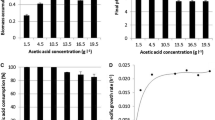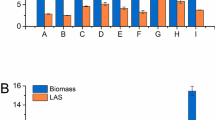Abstract
Kojic acid production byAspergillus flavus strain S44-1 using sucrose as a carbon source was carried out in a 250-mL shake flask and a 2-L stirred tank fermenter. For comparison, production of kojic acid using glucose, fructose and its mixture was also carried out. Kojic acid production in shake flask fermentation was 25.8 g/L using glucose as the sole carbon source, 23.6 g/L with sucrose, and 6.4 g/L from fructose. Reduced kojic acid production (13.5 g/L) was observed when a combination of glucose and fructose was used as a carbon source. The highest production of kojic acid (40.2 g/L) was obtained from 150 g/L sucrose in a 2 L fermenter, while the lowest kojic acid production (10.3 g/L) was seen in fermentation using fructose as the sole carbon source. The experimental data from batch fermentation and resuspended cell system was analysed in order to form the basis for a kinetic model of the process. An unstructured model based on logistic and Luedeking-Piret equations was found suitable to describe the growth, substrate consumption, and efficiency of kojic acid production byA. flavus in batch fermentation using sucrose. From this model, it was found that kojic acid production byA. flavus was not a growth-associated process. Fermentation without pH control (from an initial culture pH of 3.0) showed higher kojic acid production than single-phase pH-controlled fermentation (pH 2.5, 2.75, and 3.0).
Similar content being viewed by others
Abbreviations
- α:
-
Growth-associated rate constant for glucose consumption (g glucose/g cell)
- β:
-
Non-growth-associated rate constant for glucose consumption (g glucose/g cell.h)
- m :
-
Growth-associated rate constant for kojic acid production (g kojic acid/g cell)
- n :
-
Non-growth associated rate constant for kojic acid production (g kojic acid/g cell.h)
- x :
-
Cell concentration (g/L)
- x max :
-
Maximum cell concentration (g/L)
- t :
-
Time (h)
- s :
-
Substrate concentration (g/L)
- p :
-
Kojic acid concentration (g/L)
References
Ariff, A. B., M. Rosfarizan, L. S. Herng, M. S. Madihah, and M. I. A. Karim (1997) Kinetics and modelling of kojic acid production byAspergillus flavus Link in batch fermentation and resuspended mycelial system.World J. Microbiol. Biotechnol. 13: 195–201.
Ariff, A. B., M. S. Salleh, B. Ghani, M. A. Hassan, G. Rusul, and M. I. A. Karim (1996) Aeration and yeast extract requirements for kojic acid production byAspergillus flavus Link.Enz. Microb. Technol. 19: 545–550.
Arnstein, H. R. V. and R. Bentley (1953) The biosynthesis of kojic acid 1. Production from [1–14] and [3: 4-14C] glucose and [2-14C]-1: 3-Dihydroxyacetone.Biochem. J. 54: 493–508.
Bajpai, P., P. K. Agrawala, and L. Viswanathan (1982) Production of kojic acid by resuspended mycelia ofAspergillus flavus.Can. J. Microbiol. 28: 1340–1346.
Bajpai, P., P. K. Agrawala, and L. Viswanathan (1981) Enzymes relevant to kojic acid biosynthesis inAspergillus flavus.J. Gen. Microbiol. 127: 131–136.
Beelik, A. (1956) Kojic acid.Adv. Carbohydr. Chem. 11: 145–183.
Gould, B. S. (1938) The metabolism ofAspergillus tamarii Kita, Kojic acid production.Biochem. J. 32: 797–783.
Kitada, M., H. Ueyama, and T. Fukimbara (1967) Studies on kojic acid fermentation (1) Cultural condition in submerged culture.J. Ferment. Technol. 45: 1101–1107.
Madihah, S., A. B. Ariff, M. A. Hassan, G. Rusul, and M. I. A. Karim (1996) Enhanced kojic acid production byAspergillus flavus Link in Growth medium containing methanol.ASEAN Food J. 11: 158–162.
Rosfarizan, M., A. B. Ariff, M. A. Hassan, M. I. A. Karim, H. Shimizu, and S. Shioya (2002) Importance of carbon source feeding and pH control strategies for maximum kojic acid production from sago starch byAspergillus flavus.J. Biosci. Bioeng. 94: 99–105.
Rosfarizan, M., A. B. Ariff, M. A. Hassan, and M. I. A. Karim (2000) Influence of pH on kojic acid fermentation byA. flavus.Pakistan J. Biol. Sci. 3: 977–982.
Rosfarizan, M., S. Madihah, and A. B. Ariff (1998) Isolation of a kojic acid-producing fungus capable of using starches as a carbon source.Lett. Appl. Microbiol. 26: 27–30.
Wei, C. I., T. S. Huang, S. Y. Fernando, and K. T. Chung (1991) Mutagenicity studies of kojic acid.Toxicol. Lett. 59: 213–220.
Weiss, R. M. and D. F. Ollis (1980) Extracellular microbial polysaccharides. I. Substrate, biomass, and product kinetic equations for batch xanthan gum fermentation.Biotechnol. Bioeng. 22: 859–864.
Author information
Authors and Affiliations
Corresponding author
Rights and permissions
About this article
Cite this article
Rosfarizan, M., Ariff, A.B. Kinetics of kojic acid fermentation byAspergillus flavus link S44-1 using sucrose as a carbon source under different pH conditions. Biotechnol. Bioprocess Eng. 11, 72–79 (2006). https://doi.org/10.1007/BF02931872
Received:
Accepted:
Issue Date:
DOI: https://doi.org/10.1007/BF02931872




